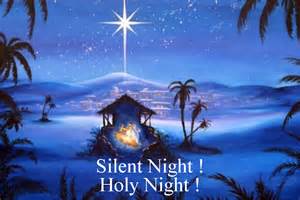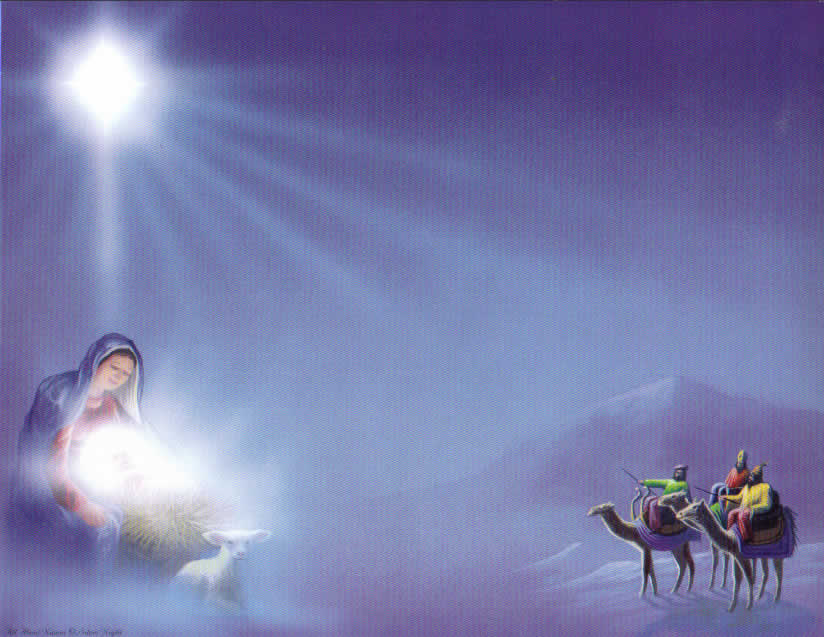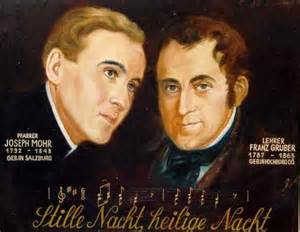Millions of Christians around the world will sing this beloved hymn “Silent Night” during the Christmas season. This favorite Christmas carol has been translated into just about every language in the world. What a joyous thought to know that so many people will be remembering the real reason for Christmas on the day of Jesus’ birth.
The story of the hymn is beautifully told by Dr. Ralph F. Wilson, Joyful Heart Renewal Ministries – joyfulheart.com
Check out the page with the Christmas stories. You will be blessed! If you are looking for good stories to share with your children, you will find many heartwarming stories at this site!
The Story of “Silent Night” —–
The phrase repeats itself over and over again in his mind:
Silent night, holy night,
Stille nacht, heilige nacht.
Father Joseph Mohr, Parish Priest
It’s the first line from a poem this young Austrian priest had written two years before. Now he can’t get the phrase out of his mind. “Silent night, holy night.”
Tonight is Christmas Eve and St. Nicholas Church in Oberndorf, north of Salzburg, will be chock-full of people. Father Joseph Mohr has a homily in mind, a message for his flock on this sacred night, but he needs a carol, something special to cap off the service.
Silent night, holy night,
All is calm, all is bright…
The words won’t go away. “I need a tune!” he says out loud, shaking his head. “I wonder if Franz can help me. I hope it’s not too late.” Franz Gruber is the schoolteacher in the nearby village of Arnsdorf — a gifted musician, organist at the Arnsdorf church, and occasional substitute organist at St. Nicholas. “Franz will help me!” he says to himself. “He can’t resist a musical challenge.”
Franz Gruber, Schoolteacher and Organist
Quickly now he slings on his heavy coat, dons a fur cap and gloves, and ventures into the brisk December morning. The snow is crunchy underfoot as he makes his way across the churchyard towards Arnsdorf, just a 20 minute walk. “Silent night, holy night … silent night, holy night.” The rhythm of the words echoes with each step.
Elizabeth opens the door at his knock. “Father Mohr, how nice of you to stop by. Franz will be glad to see you.” She takes his coat and ushers him in. Franz is picking something out on his guitar.
“Franz, remember that poem I told you about: ‘Silent Night’?” says Mohr. “I know it’s too late to ask, but could you help put a tune to it? I want to sing it tonight for Christmas Eve.”
Gruber’s face lights up. A challenge. A song. He takes the lyrics from the priest and begins to say them over and over, looking for a cadence. Then he hums a line and scratches it down.
Mohr soon tires of the process and begins to play with the children. But within an hour or so, Gruber seems to have a melody and is working out the chords on his guitar. “Father, how does this sound?” he calls and begins to sing the words:
Silent night, holy night,
All is calm all is bright…
He stops to make a correction in the manuscript, and then continues:
…’Round yon virgin, Mother and Child,
Holy infant so tender and mild,
Sleep in heavenly peace!
Sleep in heavenly peace!
Father Mohr is ecstatic. On the second verse Gruber’s deep voice is joined by Mohr’s rich tenor. Elizabeth, baby on her hip, who has been humming along, now joins them on the last verse. The song fills their home with its gentle words and memorable melody.
Christmas Eve at St. Nicholas Church, Oberndorf, 1818
That night, December 24, 1818, the song fills St. Nicholas Church at Midnight Mass. Mohr sings tenor, Gruber bass, and the church choir joins the refrain of each verse, while Mohr accompanies on the guitar. By the time the last notes die away, the worshipers are a-buzz with joy and wonder at the song. On Christmas Day, the song is being hummed and sung in dozens of homes around Oberndorf. “Silent night, holy night.”
And in Oberndorf, they would sing their beloved carol again and again each Christmas. The song might have stayed right there had it not been for an organ builder named Karl Mauracher, who came to repair the pipe organ at Arnsdorf in 1819 and made several trips to Oberndorf over the next few years, finally building a new organ for St. Nicholas in 1825.
The Song Finds Its Way to Emperors and Kings — and to America
Whether Mauracher found the music and lyrics on the organ or they were given to him by Gruber, we don’t know. But he carried the song to the Ziller Valley east of Innsbruk, where he shared it with two local families of travelling folk singers, the Rainers and the Strassers, who began to sing it as part of their regular repertoire. The following Christmas of 1819, the Rainer Family Singers sang “Stille Nacht” in the village church of Fügen (Zillertal).
Three years later they sang it for royalty. Emperor Francis I of Austria and his ally Czar Alexander I of Russia were staying in the nearby castle of Count Dönhoff (now Bubenberg Castle). The Rainer Family performed the carol and were invited to Russia for a series of concerts.
In 1834 the Strasser Family Singers sang “Silent Night” for King Frederick William IV of Prussia. He was so taken with what the Strassers called their “Song of Heaven,” that he commanded it to be sung by his cathedral choir every Christmas Eve. It spread through Europe and in 1839 the Raniers brought the song to America as the “Tyrolean Folk Song.” Since then it has been translated into over 300 languages and dialects.
Various English translations blossomed, but the definitive English version of the song was penned by Rev. John Freeman Young and first published in The Sunday-School Service and Tune Book (1863).
Why Is “Silent Night” So Popular?
Why has “Silent Night” become our most beloved carol? Is it the words — tender, intimate, gentle? Or the tune — so peaceful, so memorable, so easy to play or pick out with one hand on the piano?
It is not a joyous, fast-paced carol like Handel’s “Joy to the World.” Nor theologically-rich like “Hark, the Herald Angels Sing” by Charles Wesley. Nor does it have a complex tune like “Angels We Have Heard on High.”
Rather, “Silent Night” is quiet and reflective, calling us to meditate on the scene. It is the ambience conveyed by both the gentle words and melody that create from this carol an oasis of peace.
“All is calm, all is bright.”
It calls us to dwell on the Madonna and Child —
“‘Round yon Virgin, mother and Child,
Holy Infant, so tender and mild,
Sleep in heavenly peace.”
You feel as the “shepherds quake at the sight.” You can imagine as “heavenly hosts sing Alleluia.” And you begin to sing “Alleluia to the King” right along with them.
Rays of backlit brilliance highlight many a religious painting, but here the picture of light is painted in words:
“Glories stream from heaven afar….”
“Son of God, love’s pure light,
Radiant beams from Thy holy face….”
Just Who is in this manger? What is the significance of this birth? What is Christmas about — really? Perhaps most of all, “Silent Night” is beloved because it reminds us in its simple, but exceedingly clear way, the truth behind it all — the truth that changes everything:
“Christ, the Savior is born!”
Sing it again this Christmas and let its gentle peace wash over you and its bold assertion renew your soul.
“Jesus, Lord, at thy birth!
“Jesus, Lord, at thy birth!”
—– While the first few paragraphs of this story have been fictionalized, the historical events are true. Joseph Mohr (1792-1848) wrote the words to “Silent Night” in 1816 while priest at Mariapharr. On Christmas Eve 1818, he asked his friend Franz Gruber (1787-1863) to write the tune for Mass that evening at St. Nicholas Church in Oberndorf where Mohr had been assigned in 1817. I’ve been careful to rely on recent historical research into the origin of the carol, much of it gathered since 1995, when a manuscript of the carol in Mohr’s hand was found, dated 1820-1825. Some of the most helpful (and accurate) information sources are: Bill Egan’s Silent Night Museum, Egan’s article “Silent Night: The Song Heard ‘Round The World,” “Silent Night, Holy Night — Notes,” Hyde Flippo’s “Silent Night and Christmas,” the Stille Nacht Gesellschaft by Manfred Fischer, director of the Silent Night Museum and Chapel in Oberndorf, Austria.
God bless you all this Christmas!!



